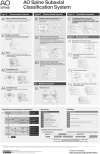Establishing the Injury Severity of Subaxial Cervical Spine Trauma: Validating the Hierarchical Nature of the AO Spine Subaxial Cervical Spine Injury Classification System
- PMID: 33337687
- PMCID: PMC8057527
- DOI: 10.1097/BRS.0000000000003873
Establishing the Injury Severity of Subaxial Cervical Spine Trauma: Validating the Hierarchical Nature of the AO Spine Subaxial Cervical Spine Injury Classification System
Abstract
Study design: Global cross-sectional survey.
Objective: The aim of this study was to validate the AO Spine Subaxial Cervical Spine Injury Classification by examining the perceived injury severity by surgeon across AO geographical regions and practice experience.
Summary of background data: Previous subaxial cervical spine injury classifications have been limited by subpar interobserver reliability and clinical applicability. In an attempt to create a universally validated scheme with prognostic value, AO Spine established a subaxial cervical spine injury classification involving four elements: injury morphology, facet injury involvement, neurologic status, and case-specific modifiers.
Methods: A survey was sent to 272 AO Spine members across all geographic regions and with a variety of practice experience. Respondents graded the severity of each variable of the classification system on a scale from zero (low severity) to 100 (high severity). Primary outcome was to assess differences in perceived injury severity for each injury type over geographic regions and level of practice experience.
Results: A total of 189 responses were received. Overall, the classification system exhibited a hierarchical progression in subtype injury severity scores. Only three subtypes showed a significant difference in injury severity score among geographic regions: F3 (floating lateral mass fracture, P = 0.04), N3 (incomplete spinal cord injury, P = 0.03), and M2 (critical disk herniation, P = 0.04). When stratified by surgeon experience, pairwise comparison showed only two morphological subtypes, B1 (bony posterior tension band injury, P = 0.02) and F2 (unstable facet fracture, P = 0.03), and one neurologic subtype (N3, P = 0.02) exhibited a significant difference in injury severity score.
Conclusion: The AO Spine Subaxial Cervical Spine Injury Classification System has shown to be reliable and suitable for proper patient management. The study shows this classification is substantially generalizable by geographic region and surgeon experience, and provides a consistent method of communication among physicians while covering the majority of subaxial cervical spine traumatic injuries.Level of Evidence: 4.
Copyright © 2021 The Author(s). Published by Wolters Kluwer Health, Inc.
Figures
Similar articles
-
Validating the Hierarchical Nature of the AO Spine Upper Cervical Spine Injury Classification System.Spine (Phila Pa 1976). 2025 Jul 15;50(14):956-964. doi: 10.1097/BRS.0000000000005297. Epub 2025 Feb 17. Spine (Phila Pa 1976). 2025. PMID: 39960095 Free PMC article.
-
The Subaxial Cervical AO Spine Injury Score.Global Spine J. 2022 Jul;12(6):1066-1073. doi: 10.1177/2192568220974339. Epub 2020 Dec 11. Global Spine J. 2022. PMID: 33302725 Free PMC article.
-
An international validation of the AO spine subaxial injury classification system.Eur Spine J. 2023 Jan;32(1):46-54. doi: 10.1007/s00586-022-07467-6. Epub 2022 Nov 30. Eur Spine J. 2023. PMID: 36449081
-
The subaxial cervical spine injury classification system: a novel approach to recognize the importance of morphology, neurology, and integrity of the disco-ligamentous complex.Spine (Phila Pa 1976). 2007 Oct 1;32(21):2365-74. doi: 10.1097/BRS.0b013e3181557b92. Spine (Phila Pa 1976). 2007. PMID: 17906580 Review.
-
AOSpine Classification Systems (Subaxial, Thoracolumbar).J Orthop Trauma. 2017 Sep;31 Suppl 4:S14-S23. doi: 10.1097/BOT.0000000000000947. J Orthop Trauma. 2017. PMID: 28816871 Review.
Cited by
-
Diagnostic accuracy of deep learning for evaluation of C-spine injury from lateral neck radiographs.Heliyon. 2022 Aug 24;8(8):e10372. doi: 10.1016/j.heliyon.2022.e10372. eCollection 2022 Aug. Heliyon. 2022. PMID: 36061007 Free PMC article.
-
Blunt Cerebrovascular Injury in the Elderly With Traumatic Cervical Spine Injuries: Results of a Retrospective Multi-Center Study of 1512 Cases in Japan.J Neurotrauma. 2023 Jun;40(11-12):1164-1172. doi: 10.1089/neu.2022.0180. Epub 2023 Mar 10. J Neurotrauma. 2023. PMID: 36719766 Free PMC article.
-
Cervical spine trauma: impact of different imaging classification systems in the clinical decision-making.Acta Biomed. 2021 Sep 10;92(S5):e2021404. doi: 10.23750/abm.v92iS5.11877. Acta Biomed. 2021. PMID: 34505843 Free PMC article.
-
Global Validation of the AO Spine Upper Cervical Injury Classification: Geographic Region Affects Reliability and Reproducibility.Global Spine J. 2024 Apr;14(3):821-829. doi: 10.1177/21925682221124100. Epub 2022 Aug 29. Global Spine J. 2024. PMID: 36036763 Free PMC article.
-
Spontaneous Osseous Fusion after Remodeling Therapy for Chronic Atlantoaxial Rotatory Fixation and Recovery Mechanism of Rotatory Range of Motion of the Cervical Spine.J Clin Med. 2022 Mar 9;11(6):1504. doi: 10.3390/jcm11061504. J Clin Med. 2022. PMID: 35329830 Free PMC article.
References
-
- Schnake KJ, Schroeder GD, Vaccaro AR, et al. . AOSpine Classification Systems (Subaxial, Thoracolumbar). J Orthop Trauma 2017; 31:S14–23. - PubMed
-
- Kwon BK, Vaccaro AR, Grauer JN, et al. . Subaxial cervical spine trauma. J Am Acad Orthop Surg 2006; 14:78–89. - PubMed
-
- Allen BL, Ferguson RL, Lehmann TR, et al. . A mechanistic classification of closed, indirect fractures and dislocations of the lower cervical spine. Spine (Phila Pa 1976) 1982; 7:1–27. - PubMed
MeSH terms
LinkOut - more resources
Full Text Sources
Medical
Research Materials
Miscellaneous


